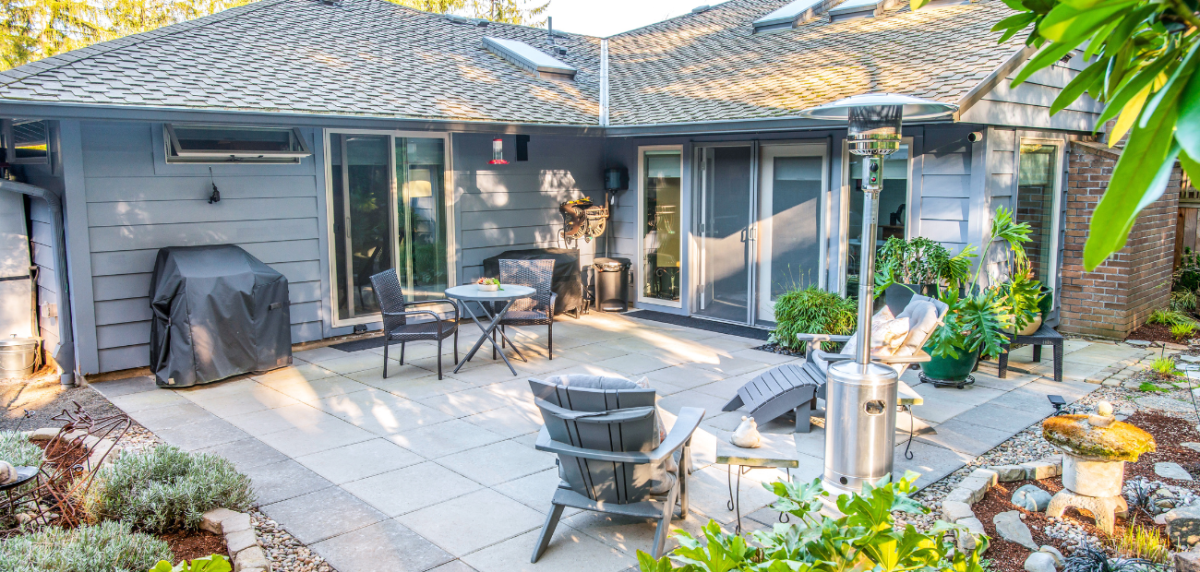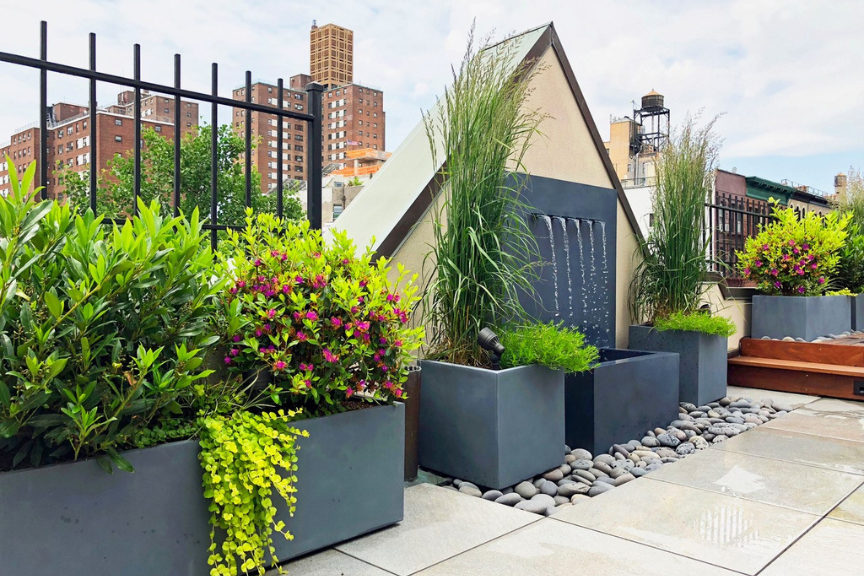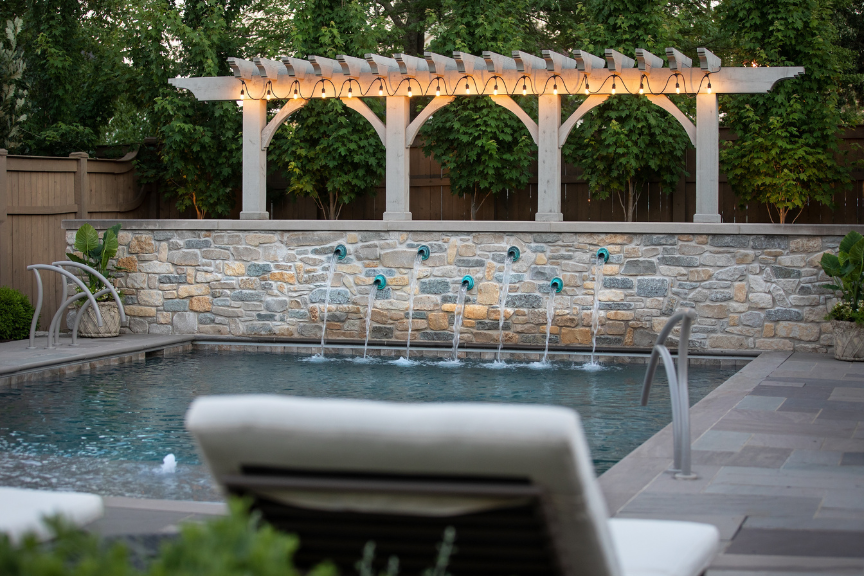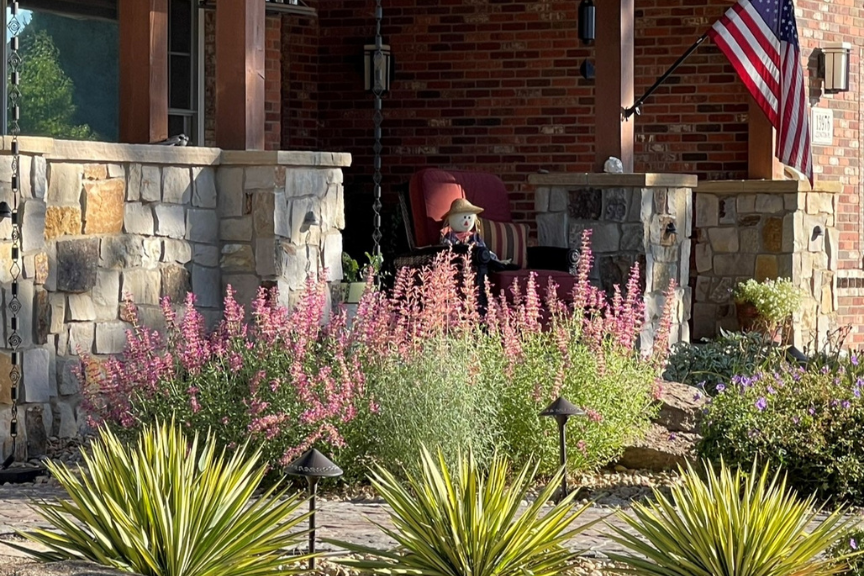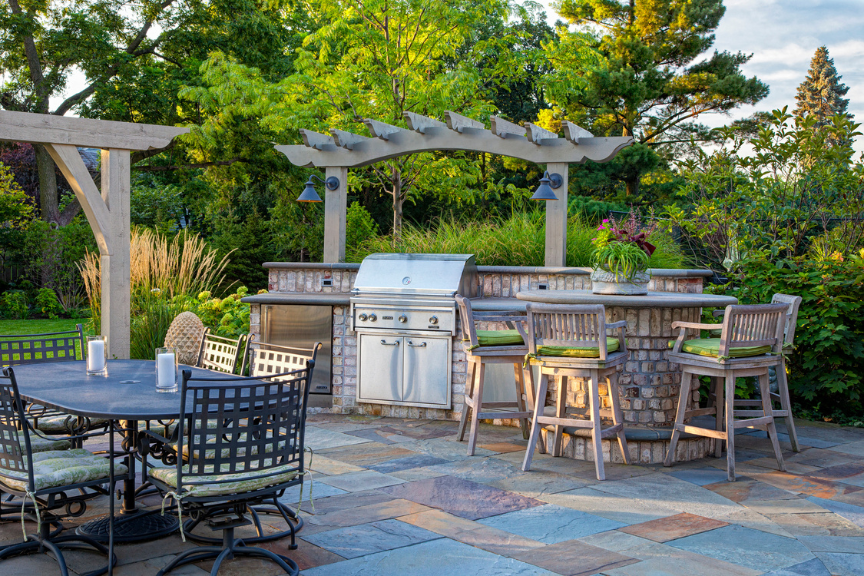Three key takeaways:
- Cost is always a factor, so homeowners should prioritize their top outcomes for their yards when deciding on how to use the space
- Sustainability and local-specific options are popular for gardens and plants
- Outdoor amenities should be intentionally designed, fitting the needs and goals of the homeowner
The desire to spend more time outdoors remains a priority for homeowners. The trend of transforming outdoor spaces into distinct “rooms” maximizes square footage with areas to cook, dine, relax, garden and be active.
While the old rule of budgeting suggested 10% of a home’s value for outdoor improvements, that number is on the rise. Steve Chepurny, landscape architect, at Southampton, N.J.-based Beechwood Landscape & Construction notes an increase of 20-25%. Denver-area landscape designer Abby Rupsa of Botanical Living puts the number in her market closer to a 15% average.
Part of the uptick is also due to labor and cost of materials, says landscape designer Michael Glassman, whose eponymous firm is based in Sacramento, Calif. “Costs have doubled and tripled in recent years,” he says. “To cut back, some homeowners do some work themselves or scale back projects. Those who stay put also put in more sustainable features that will last,” Glassman says.
Yards are often versatile spaces that can offer everything from leisure to fun. Sometimes though, it’s hard to know where to start. Seasoned homeowners offer the following tips to help:
- Plant according to a local climate, water and soil specifications.
- Develop a cohesive design plan up front.
- Forgo features that require lots of maintenance and will detract from leisure time, unless hiring help is part of the budget.
Below is a compendium of popular options.
Pools and Water Features
Pool trends continue to shift, but it is clear that homeowners continue to prioritize water features. Chepurny has had several clients who asked to remove their existing pools for modern designs with better materials such as gunite instead of vinyl. Updates to tile and surrounds are also in demand. The classic rectangle is again gaining traction. John Algozzini, senior design associate at Chicago area Hursthouse, says 90% of his firm’s clients want a rectangular pool. Smaller pools and spools—splash pools—are popular based on available space and lot coverage restrictions, he adds.
Many pools may incorporate water jets and walls, sun shelves in the shallow end, deeper diving zones, an adjacent spa, lights for night-time use thanks to LED technology and an area for a cabana to give a resort feel. Even in urban areas, water features are popular. Designer Amber Freda of New York-based Amber Freda Landscape Design says clients like the zinc fountains from Restoration Hardware, which recirculate and don’t require plumbing. “All you do is refill them with a garden hose,” she says.
Plants and Landscaping
With concern about the survival of bees, butterflies and birds, more professionals encourage the use of plant species that attract them such as native cone flowers, native black-eyed Susans and milkweed, says Algozzini.
Go native
A native landscape encourages local pollinators, which means plants are heartier and healthier and can conserve water. Because of her Denver area’s high desert plains elevation, Rupsa says her palette is narrow, so she tends to repeat choices such as Hardy geranium, Hyssop, Yucca, Manzanita and Spirea.
Conserve water
More homeowners are cognizant of water usage in their homes and their gardens. To conserve water, Ruspa focuses on xeriscape gardens with drought-tolerant plants. She also incorporates small pocket lawns with new lower water Bermudagrass called Tahoma 31 rather than Kentucky Bluegrass, which requires more water than other cool grasses.
Keep it wild
Ruspa also sees a trend toward a more natural even wild look, though sometimes it can be a challenge for HOAs to appreciate. She uses ornamental grasses such as Grama Grass, Switchgrass and stipa. She also incorporates pollinator-friendly perennials that have interesting structure and provide seed heads for hungry birds. She inserts boulders and smaller rocks in faux riverbeds to add winter interest and break up plantings. She will often recommend clients not clean up their fallen leaves during dormancy to provide cover for beneficial insects.
Make it edible
Edible landscapes remain popular, and Freda has had success with blueberries, strawberries, figs and grapes for her New York area clients, some of whom garden on rooftops.
The key to a flourishing edible garden is to pay attention to two factors: what grows well in which seasons and what works for a homeowner’s specific location.
Pops of color
Marc Nissim, landscape architect at Westfield, N.J.-based Harmony Design Group, advises aiming for color throughout the year. “Our goal is to design a garden with four seasons of interest. He has a list of favorites that add color and texture to each season:
Spring – flowering trees such as cherry blossoms and magnolias, shrubs like forsythia and lilac and bulbs like daffodils and tulips
Summer – perennials like Catnip, Purple coneflower and Black-eyed Susan, flowering shrubs like hydrangea and roses, and flowering trees like Crape myrtle for color
Fall – red maple, a perennial like Amsonia or a shrub like Itea Sweetspire
Winter – the Paperbark maple or the movement of ornamental grass, a shrub like Lindera angustifolia spicebush or Cornus alba red twig dogwood
Outdoor Kitchens and Dining
Cooking outdoors remains a widespread interest, but some professionals note an uptick in homeowners requesting less elaborate, smaller kitchens. Algozzini sees interest in a range of sizes, sophistication and prices. “Some want one with just a grill, counter and refrigerator and others want the grill, refrigerator, storage drawers, warming drawer, pizza oven, smoker and more,” he says.
Adds Nissim, “Creating an outdoor kitchen often can include a bar with granite countertop. This adds another seating area and a spot to hang out with the chef!” Chepurny says the decision process is “really a quality-of-life decision. Many still work from home post-Covid and are willing to pay to have such features.”
Relaxation Zones
Near a kitchen, most homeowners still favor a comfortable place to eat and entertain, with a cover to offer shade and shelter from rain and bugs. Nissim likes to use these spaces to add lighting. Algozzini sees interest in traditional cedar, composite materials and aluminum, the latter more expensive. Some add shades to pull down, which can be automated, a fan to move air and lighting for night-time use.
Furniture groupings can serve as the equivalent of an indoor wall to mark zones. Other features that remain popular are fire pits, art for color, soft seating and outdoor TV and sound systems, Nissim says. For those who have the space and the funds, pickleball courts or a combination pickleball/basketball court, putting green and tennis court are becoming more common.
Additional favorites: permeable hardscape, bigger sheds, better irrigation
Gardens aren’t all softscape and amenities. Popular options that conserve water include bluestone, limestone and gravel. Gravel allows for a semi-permeable surface that lets water recharge and soak into the soil, Chepurny says. Freda recommends nontoxic materials such as petroleum-free artificial turf, due to concern about pets and children being around materials that may be hazardous to their health. In between pavers, Chepurny plants “steppables” or creeping perennials like sedum that tolerate a little trampling, he says.
For those wanting an escape from work, a hobby or storage, there’s a trend of having bigger sheds. Some mimic small homes with cupolas, windows and window boxes, Chepurny says.
When it comes to irrigation systes, the good news is that many incorporate smart controls to track temperature and time of day, he says. Drainage should be prioritized; otherwise, there can be water damage, erosion and flooding, says Aaron Brundage, director of operations at Orange County, Calif.-based System Pavers, an outdoor living and installation company.


